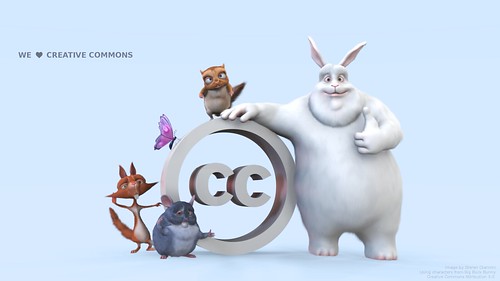When I first wrote about redefining my concept of what it means to "do your own work," I focused on Vygotsky's concepts of ZPDs and the importance of collaborative work for learning and development. An equally important issue for redefining what it means to "do your own work" in a technology-rich classroom is the idea of “remixing,” i.e., “writing by appropriation: taking bits, pieces, and ideas and compiling and remixing them in new and innovative ways” (Devoss, pg. 80).
In his article "Copy Your Homework: Free Culture and Fair Use with Wikimedia Commons," Michael Mandiberg discusses how he uses image appropriation (particularly through Wikimedia Commons) in his classes to teach students about issues of plagiarism, copyright, Creative Commons, Public Domain, ethical composition, legal appropriation, etc. As Mandiberg states, "most of [students'] courses have repeatedly enforced the notion that taking anyone else’s work ... is plagiarist theft." Mandiburg's article provides a detailed discussion of broaching these new ideas about authorship and ethical writing with students and broadening their understanding past their ingrained ideas about plagiarism. While plagiarism (outright intellectual stealing) is an important issue that must be addressed, it is important for students to move beyond this simplistic view of what it means to compose ethically and legally - "more than just clarifying what is and is not plagiarism, learning the rules of free and fair use liberates students to embrace the culture of appropriation they grew up in and create works for that context" (Mandiberg).
Mandiberg's article deals specifically with image appropriation. However, teaching students appropriate methods of and contexts for remixing goes far beyond images. In, Because Digital Writing Matters, the discussion on remixing includes examples of a high school student intern and a volunteer for a local nonprofit organization who both remix portions of a previously existing press release used by the organization to create a press release for a new event (on the part of the student intern) and new Web content (on the part of the volunteer).
This is something that I’ve had to do many times work. However, because of my ingrained ideas about plagiarism, I struggled a bit initially with these activities. For example, we recently added a new set of functions to bcpLearning and I was asked to write a section for the help file to teach users how to make use of the new functionality. Even though it made sense to use already existing copy and modify it to work with the new material, I felt a little bit like I was “cheating” and not doing my job because the help file I created was not entirely my own original work. In reality, I was doing my job. Using already existing material helped me create a new document that fit stylistically with the old help file in much less time than if I had I written the new help section without using any of the already existing material. In another instance, I was asked to look at copy for a previous promotional email and modify it for a new product. My manager was not concerned with the fact that I “remixed” previously existing material, he only cared that I completed the projects effectively and in a timely manner.
Were any of these “remixing” activities acts of plagiarism? No. The intern’s, volunteer’s, and my own activities were all appropriate for their contexts and the expectations governing those situations. As this is a common scenario in the workplace (which will only become more prominent as digital communication builds in prevalence), it is important that remixing be taught in the classroom along with specific discussions regarding the differences in expectation for various composition environments. This will allow students to develop both the skills to create remixed projects and the ability to determine what expectations they are operating under and whether “remixing” is appropriate in a given situation. I particularly liked the two remix assignments discussed by Shari in our course, one “taken” and one “allowed to take.” This represents for me one potential option for teaching students about remixing and the different expectations for different writing environments.
Sources
1. DeVoss, Dànielle Nicole., Elyse Eidman-Aadahl, and Troy Hicks. Because Digital Writing Matters: Improving Student Writing in Online and Multimedia Environments. San Francisco: Jossey-Bass, 2010. Print.
2. Mandiberg, Michael. "Copy Your Homework: Free Culture and Fair Use with Wikimedia Commons." Learning Through Digital Media Experiments in Technology and Pedagogy. Ed. R. Trebor Scholz. Web. 27 July 2011.
No comments:
Post a Comment